Once the capital of Thailand’s Lanna Kingdom, Chiang Mai serves as a northern hub to many interested in it’s vast cultural and natural offerings.
Known for it’s silk and hand woven textiles, this “Rose of the North” is a welcome respite from the hustle and bustle of Bangkok.
Chiang Mai is surrounded by mountains and a lush country making for an all together different experience than the capitol.
What to do in Chiang Mai
Chiang Mai is one of my most favorite cities in the world. There is so much to see and do here.
Whether you are looking to be immersed in culture, savoring the local food, exploring the countryside or experiencing the soul quieting Buddhist temples, Chiang Mai has it all.
Here are just a couple suggestions if you are short on time:
Bo Sang Umbrella Factory is a family-owned and operated business located just outside of Chiang Mai. They produce around 300 umbrellas per day using traditional techniques that have been used for centuries.
Each product is made from natural materials such as bamboo or coconut leaves which are handcrafted into a beautiful work of art.
Chiang Mai is known as the cultural capital of Thailand, so it’s no surprise that this city has some of the most delicious street food in all of Asia. And yes, they even have a lot of excellent choices for vegan food!
If you’re looking for a culinary adventure that will leave your mouth watering and your stomach satisfied, then look no further than Chiang Mai’s famous Khao Soi noodles.
Chiang Mai Temples
Considered the center of Buddhism in Northern Thailand and overflowing with more than 200 temples, or wats.
Aside from Wat Doi Suthep, two of the most popular Chiang Mai temples are Wat Phra Singh and Wat Chedi Luang.
Wat Phra Singh
As Chiang Mai’s most revered temple, visitors flock to Wat Phra Singh to take in it’s Lanna art, architecture and resident Phra Singh Buddha (and therein lies the origins of it’s name).
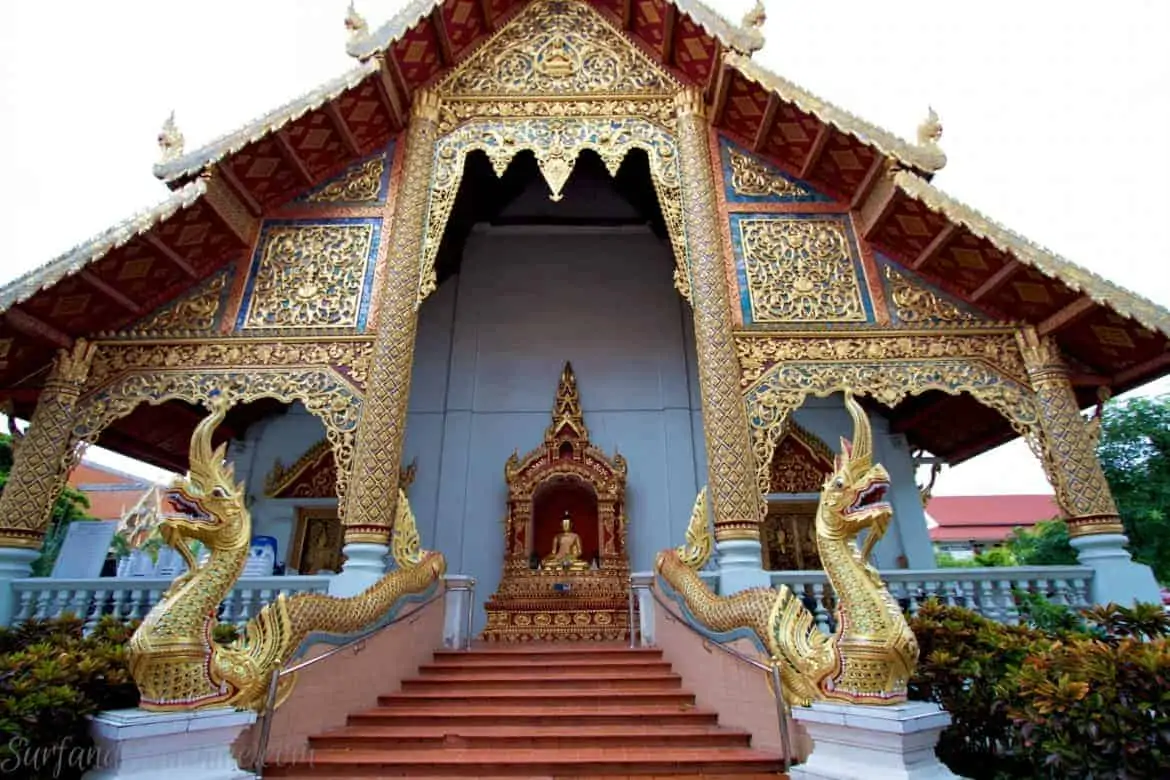
Wat Phra Singh, whose main entrance is guarded by lions, sits in the old city centre of Chiang Mai at the end of the main street (Rachadamnoen Road) and was built in 1345.
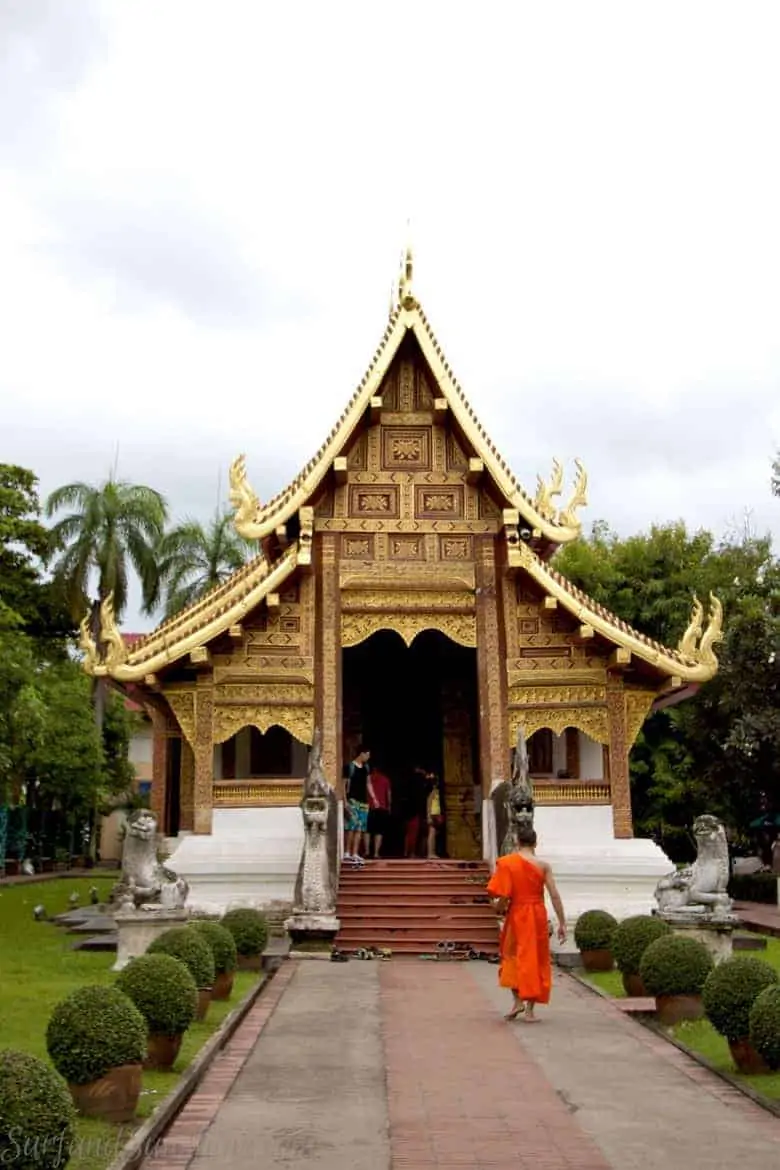
The Phra Singh Buddha, also known as the Lion Buddha, is housed in a small chapel at the back of the temple grounds.
The building is beautiful with its three-tiered roof and carved gables.
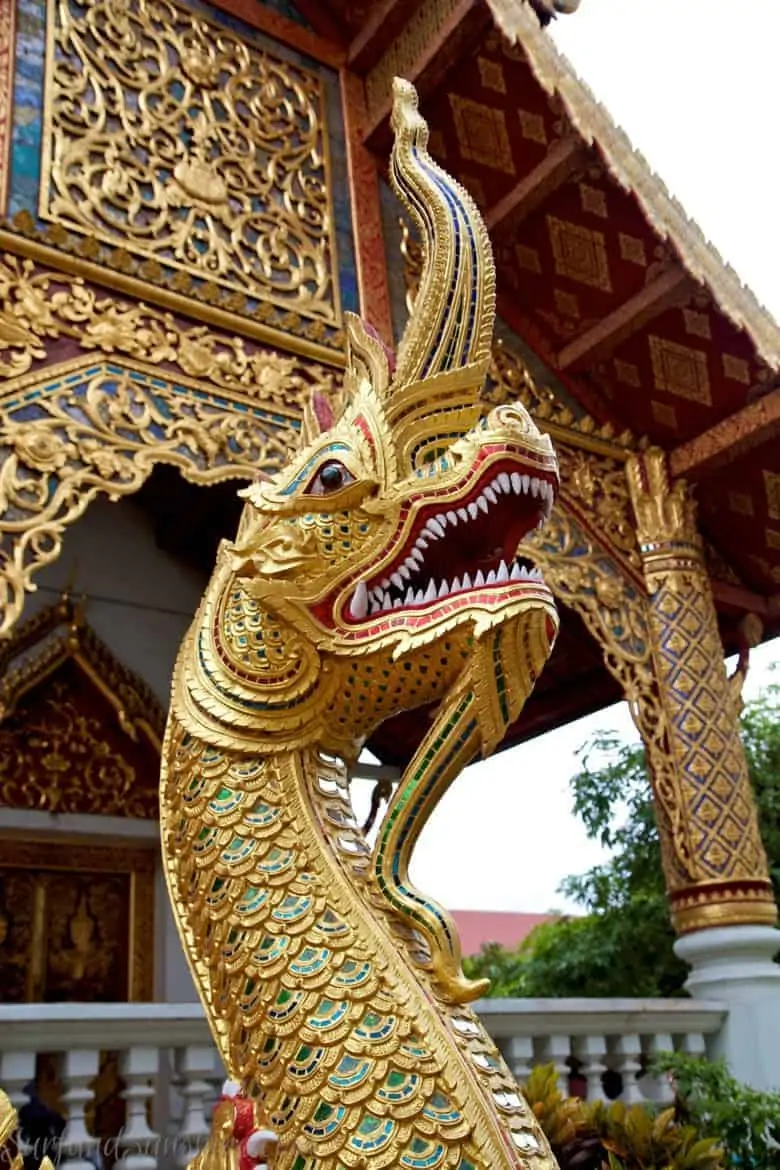
The inside is just as amazing with gold-pattern stenciling (called lai·krahm) and extensive murals.
Purchase incense and flowers to donate during your visit and you may receive a blessing from a senior Monk.

Despite it’s fame, very little is known about the Phra Singh but there are many rumors. Nevertheless, it’s revered as one of the most beautiful examples of Lanna art.
However, there are two nearly identical images in Nakhon Si Thammarat and Bangkok, so no one knows if this is the real one and no one surely knows it origin.
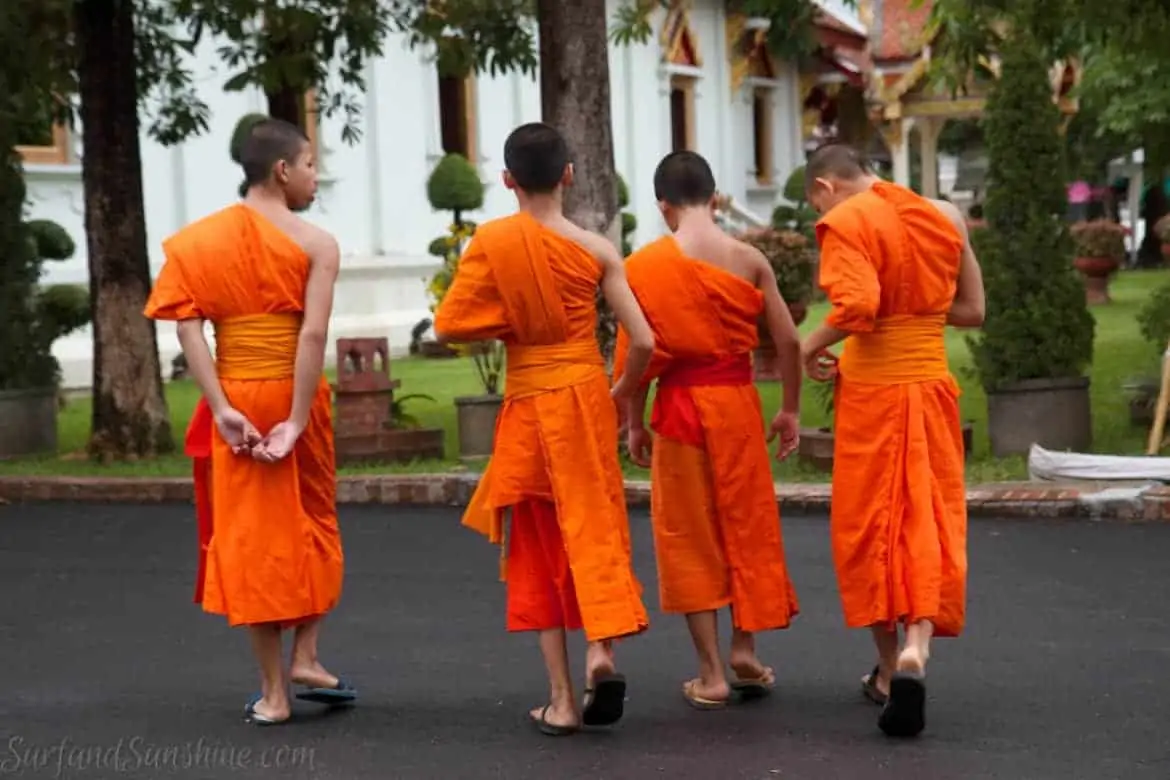
The grounds also feature the main chedi with a unique octagonal shape along with a learning center for boys and young men to study to become Novice Monks.
Under the shade of red umbrellas, a street market lines the walkway to the rear of the property and offers clothing, trinkets and food.

TIP: The absolute best bowl of Khao Soi noodles can be had here for just 40 Thai Baht (about $1.30 USD).
Wat Chedi Luang
The Wat Chedi Luang is one of the most beautiful temples in all of Thailand.
The temple has been called the most beautiful and extravagant of its kind in all of Northern Thailand.

Also known as the Temple of the Big Stupa, this amazing ruined temple in the heart of Chiang Mai dates back to the 14th or 15th century.
King Saen Muang Ma (r.1385-1401) began construction on Wat Chedi Luang in 1391 to hold the ashes of his father, Ku Na.

Then, it was then given the great honor of housing the Emerald Buddha, the holiest religious object in Thailand (which is now kept in Wat Phra Kaew at the Grand Palace in Bangkok).
The temple continued to grow to a height of 280 ft until 1545 when a severe earthquake toppled part of the great spire.

Even then, it remained the tallest structure in Chiang Mai until modern times.
The ruined brick chedi of Wat Chedi Luang now rises an impressive 60m in height and is still home to many Buddha Shrines.
Although partly ruined, each of it’s four sides are guarded by stone nagas (mythical snakes) and elephants stand guard midway up the platform.

But what we find really interesting is that it’s not just a pretty face: Wat Chedi Luang also houses relics from two different religions – Buddhism and Hinduism!
This gives visitors an opportunity to see how these two religions intersected before they became separate entities. If you are visiting Chiang Mai, be sure to see this UNESCO World Heritage Site for yourself.
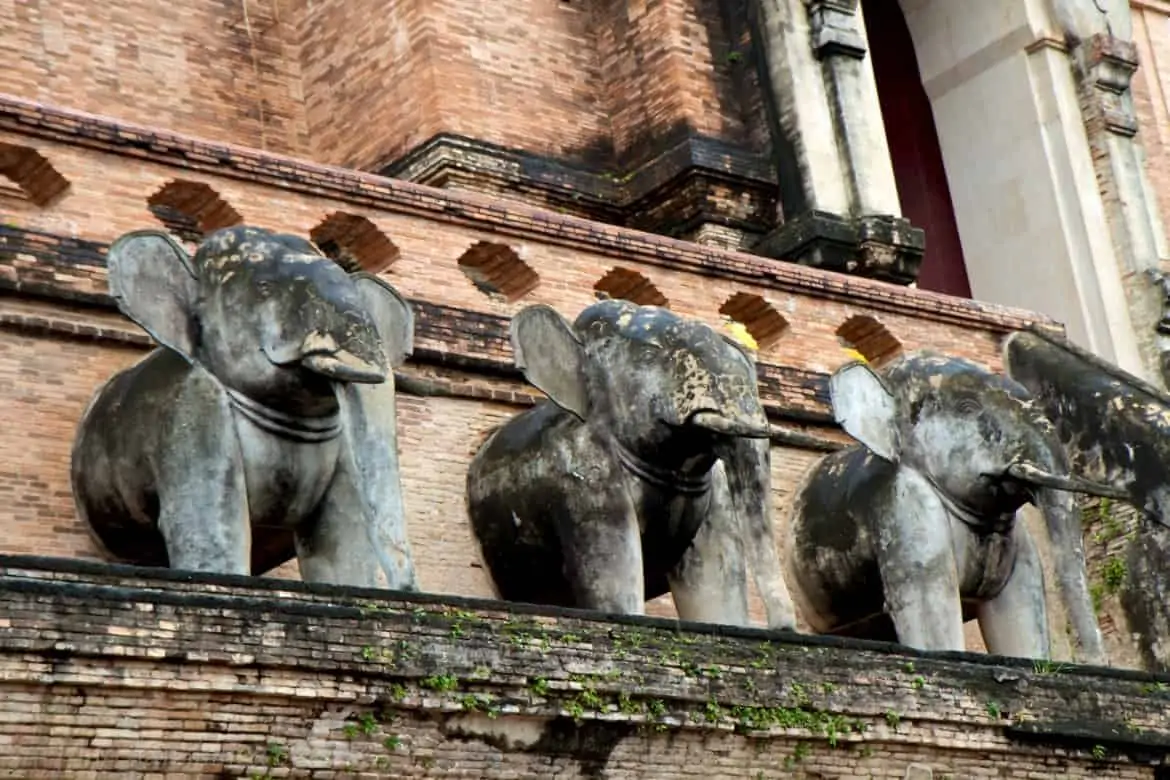
This “Royal Pagoda” is currently being renovated and the work completed thus far is stunning.
Be sure to take a walk around the entire structure as there is more to be seen on the back side, including donation boxes and bells for each Zodiac animal.
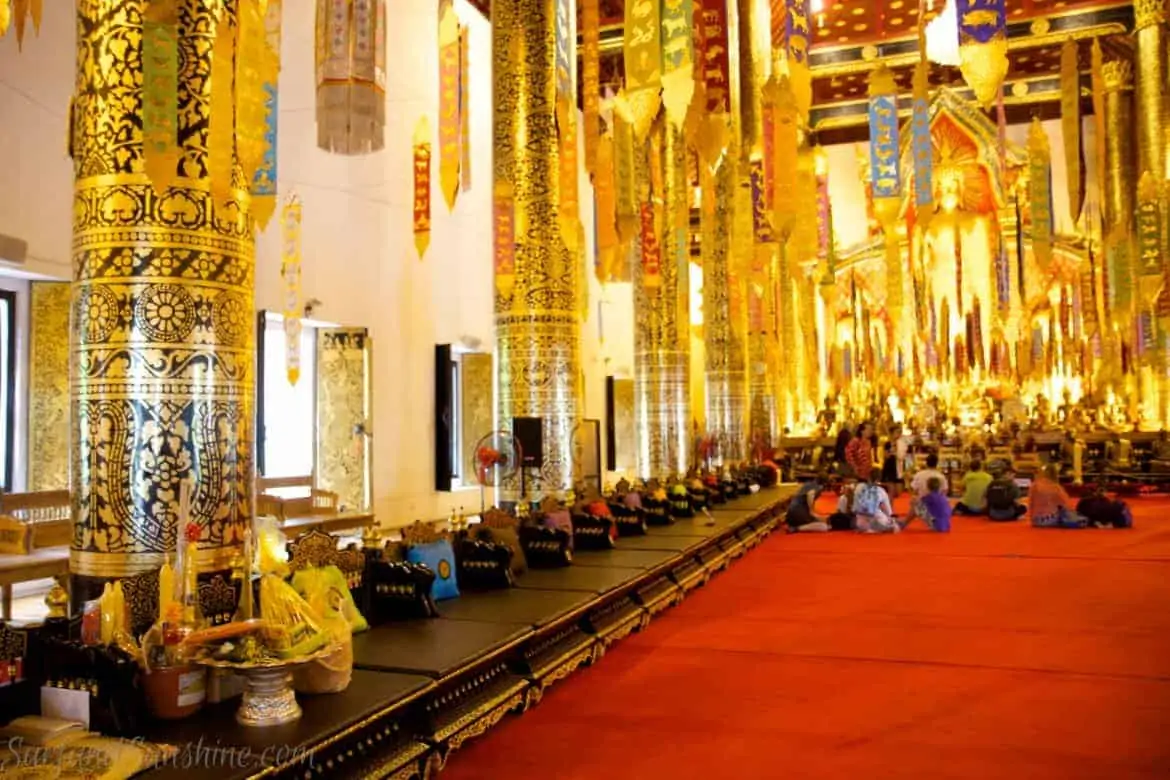
According to ancient local belief when people die their spirit will stay in the chedi of their Zodiac animal sign.
Although each sign has an official temple in Thailand, these donation bins allow visitors to pay homage to their sign without having to travel to their specific temple (which may be some distance away from Chiang Mai).
Next to the chedi sits a large assembly hall with round columns holding up a red ceiling above a Buddha known as Phra Chao Attarot. Dating back to the late 14th century, this large standing Buddha sits high above the crowd in the back of the hall.

The entire area in front is a mesmerizing array of Zodiac banners purchased and placed by the faithful in hopes of bringing merit to themselves and their family.
Outside to the left, visitors have the opportunity to leave a donation in turn for writing on a tile that will be placed on the roof of the structure. On the other side of the chedi is another pavilion housing a reclining Buddha statue.
Don’t miss the large Dipterocarp tree (gum tree) that by lore protects the temple and the city of Chiang Mai in the southeast corner.
Legend has it that if the tree is to fall, a catastrophe will soon follow.
Also standing guard is the ‘Spirit of the City’ pillar, enshrined next to the tree in a cross shaped building.
As with all Buddhist temples, visitors should be respectful and dress modestly when visiting these wats. Wear clothing that covers shoulders and knees and leave your shoes outside before entering. If taking photos, make sure you are seated or kneeling first.
Those are gorgeous places! Never been to Thailand, but would love to see them in person someday!
Oh wow! These temples and photos are beautifully stunning! Thank you for sharing.
These places are just gorgeous and I would love to see them some day. I love the history and all the beautiful work that was done to build them. It is so amazing how much work was but into these buildings and statues. Thanks for sharing.
Those photos are so amazing. I would love to see these in person!
Those are gorgeous views. I would love to see those ornate buildings in person, must be breathtaking.